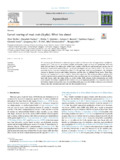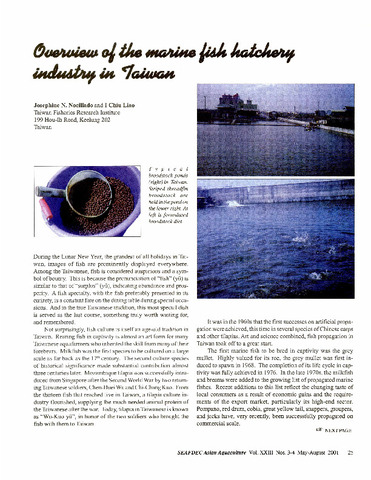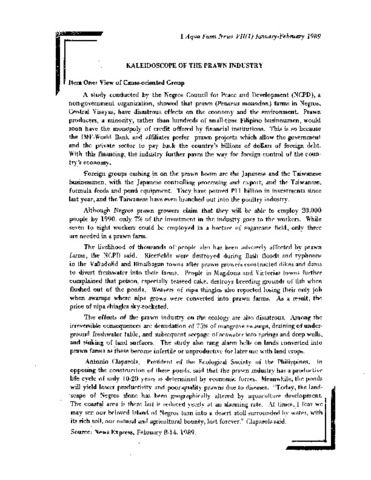Fisheries, cultivation and research aspects of mud crab (Genus Scylla) in China
| dc.contributor.author | Wang, Gui-Zhong | |
| dc.contributor.editor | Quinitio, Emilia T. | |
| dc.contributor.editor | Estepa, Fe Dolores P. | |
| dc.contributor.editor | Thampi Sam Raj, Yohannan C. | |
| dc.contributor.editor | Mandal, Anup | |
| dc.coverage.spatial | China | en |
| dc.date.accessioned | 2017-09-04T10:09:10Z | |
| dc.date.accessioned | 2017-09-04T10:40:28Z | |
| dc.date.accessioned | 2017-09-05T08:49:12Z | |
| dc.date.available | 2017-09-04T10:09:10Z | |
| dc.date.available | 2017-09-04T10:40:28Z | |
| dc.date.available | 2017-09-05T08:49:12Z | |
| dc.date.issued | 2015 | |
| dc.identifier.citation | Wang, G.-Z. (2015). Fisheries, cultivation and research aspects of mud crab (Genus Scylla) in China. In E. T. Quinitio, F. D. Parado-Estepa, Y. C. Thampi Sam Raj, & A. Mandal (Eds.), Proceedings of the International Seminar-Workshop on Mud Crab Aquaculture and Fisheries Management, 10-12 April 2013, Tamil Nadu, India (pp. 7-15). Tamil Nadu, India: Rajiv Gandhi Centre for Aquaculture (MPEDA). | en |
| dc.identifier.isbn | 9788192989815 | |
| dc.identifier.uri | http://hdl.handle.net/10862/3205 | |
| dc.description.abstract | Mud crabs are distributed only along the coastal areas of southeast China. Of the four Scylla species found in China, Scylla paramamosain is the dominant species. The annual wild catch of mud crabs in mainland China was 60,000-70,000 mt. The highest annual production from farming was 120,000 mt. The main species cultured is S. paramamosain. Fattening (involves the feeding of immature female crabs until their ovaries become mature), polyculture and monoculture are commonly practiced. Farming is done in earthen ponds and pens in intertidal zone and mangrove area. The seeds for farming are mostly from the wild and only about 10% are sourced from the hatchery. Occurrence of diseases and differences in the population are the main problems in mud crab farming in China. At present, research activities on mud crab that are being undertaken include reproductive biology, hatchery and farming technology. Further research on the prevention of diseases and development of formulated diets (ingredient selection, nutritional requirements, pellet size, shape and stability) are necessary. | en |
| dc.language.iso | en | en |
| dc.publisher | Rajiv Gandhi Centre for Aquaculture (MPEDA) | en |
| dc.subject | Scylla paramamosain | en |
| dc.subject | China | en |
| dc.subject | cultivation | en |
| dc.subject | Scylla | en |
| dc.title | Fisheries, cultivation and research aspects of mud crab (Genus Scylla) in China | en |
| dc.type | Conference paper | en |
| dc.citation.spage | 7 | |
| dc.citation.epage | 15 | |
| dc.citation.conferenceTitle | Proceedings of the International Seminar-Workshop on Mud Crab Aquaculture and Fisheries Management, 10-12 April 2013, Tamil Nadu, India | en |
| dc.subject.asfa | breeding | en |
| dc.subject.asfa | biology | en |
| dc.subject.asfa | diseases | en |
| dc.subject.scientificName | Scylla paramamosain | en |
| dc.subject.scientificName | Scylla | en |
Files in this item
| Files | Size | Format | View |
|---|---|---|---|
|
There are no files associated with this item. |
|||
This item appears in the following Collection(s)
-
International Seminar-Workshop on Mud Crab Aquaculture and Fisheries Management (ISMAF 2013) [15]
Proceedings of the International Seminar-Workshop on Mud Crab Aquaculture and Fisheries Management, 10 - 12 April 2013




